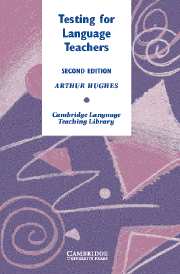Book contents
- Frontmatter
- Contents
- Acknowledgements
- Preface
- 1 Teaching and testing
- 2 Testing as problem solving: an overview of the book
- 3 Kinds of tests and testing
- 4 Validity
- 5 Reliability
- 6 Achieving beneficial backwash
- 7 Stages of test development
- 8 Common test techniques
- 9 Testing writing
- 10 Testing oral ability
- 11 Testing reading
- 12 Testing listening
- 13 Testing grammar and vocabulary
- 14 Testing overall ability
- 15 Tests for young learners
- 16 Test administration
- Appendix 1 The statistical analysis of test data
- Appendix 2 Item banking
- Appendix 3 Questions on the New Zealand youth hostels passage
- Bibliography
- Subject Index
- Author Index
- Frontmatter
- Contents
- Acknowledgements
- Preface
- 1 Teaching and testing
- 2 Testing as problem solving: an overview of the book
- 3 Kinds of tests and testing
- 4 Validity
- 5 Reliability
- 6 Achieving beneficial backwash
- 7 Stages of test development
- 8 Common test techniques
- 9 Testing writing
- 10 Testing oral ability
- 11 Testing reading
- 12 Testing listening
- 13 Testing grammar and vocabulary
- 14 Testing overall ability
- 15 Tests for young learners
- 16 Test administration
- Appendix 1 The statistical analysis of test data
- Appendix 2 Item banking
- Appendix 3 Questions on the New Zealand youth hostels passage
- Bibliography
- Subject Index
- Author Index
Summary
We already know from Chapter 2 that a test is said to be valid if it measures accurately what it is intended to measure. We create language tests in order to measure such essentially theoretical constructs as ‘reading ability’, ‘fluency in speaking’, ‘control of grammar’, and so on. For this reason, in recent years the term construct validity has been increasingly used to refer to the general, overarching notion of validity.
It is not enough to assert that a test has construct validity; empirical evidence is needed. Such evidence may take several forms, including the subordinate forms of validity, content validity and criterion-related validity. We shall begin by looking at these two forms of evidence in turn, and attempt to show their relevance for the solution of language testing problems. We shall then turn to other forms of evidence.
Content validity
The first form of evidence relates to the content of the test. A test is said to have content validity if its content constitutes a representative sample of the language skills, structures, etc. with which it is meant to be concerned. It is obvious that a grammar test, for instance, must be made up of items relating to the knowledge or control of grammar. But this in itself does not ensure content validity. The test would have content validity only if it included a proper sample of the relevant structures.
- Type
- Chapter
- Information
- Testing for Language Teachers , pp. 26 - 35Publisher: Cambridge University PressPrint publication year: 2002
- 1
- Cited by



